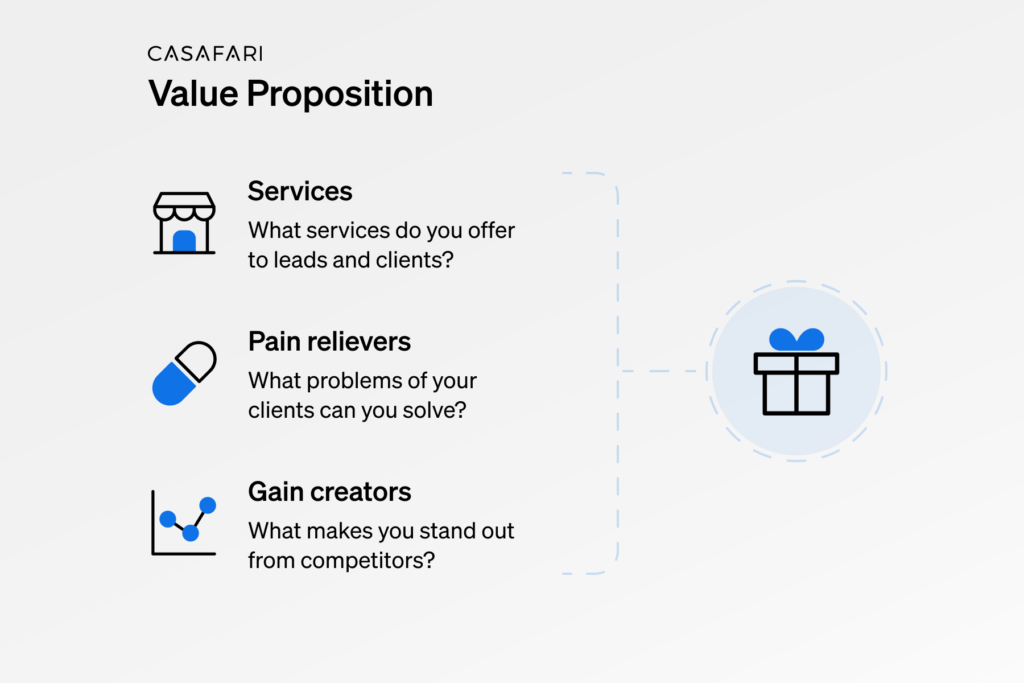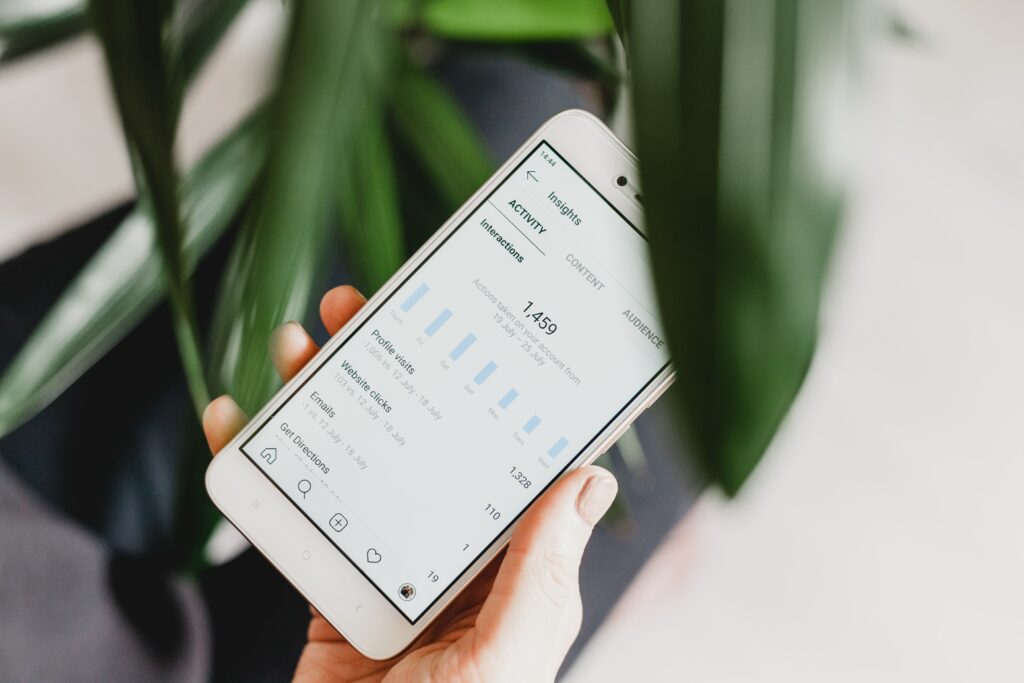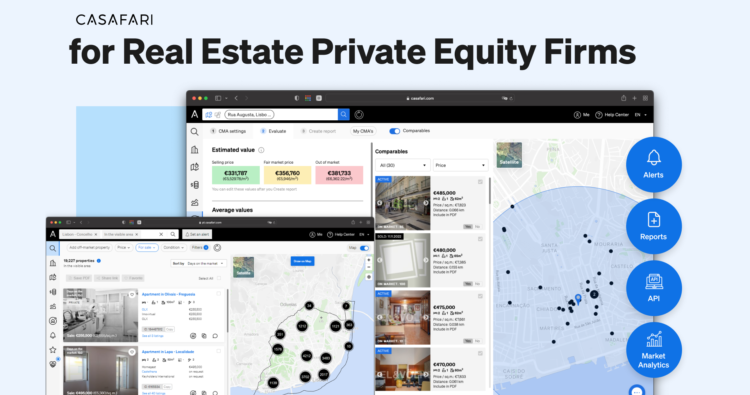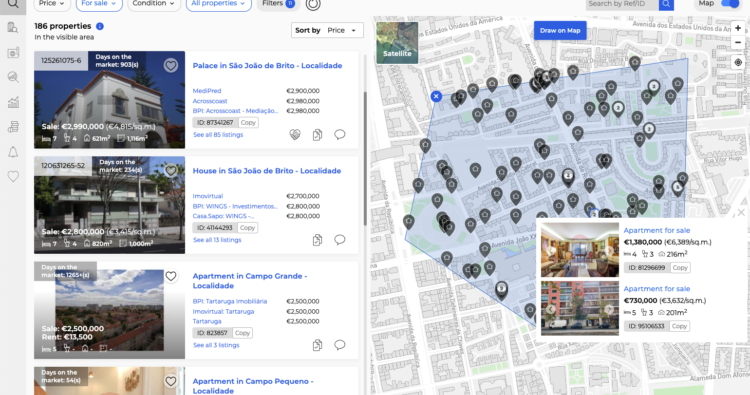Grow your property portfolio, take better photography for real estate, seal more deals, attract new leads, visit apartments, answer information requests… Seems like the work of the estate agent to ensure a good revenue is a hard one!
Here enters real estate marketing, a group of online and offline practices that can boost your business, enabling deals at a faster pace and in a more efficient way. Check this article to better understand what real estate marketing is, see where to start with yours and get a whole lot of tips and tricks.
Content index:
- What is real estate marketing?
- What to consider in your real estate marketing plan
- Real estate marketing: set your plan in motion
- How to do social media marketing for real estate?
- Social media for real estate: 5 content ideas for your profile
- Tips for professional-looking real estate photography
What is real estate marketing?
Real estate marketing, also called property marketing, is the development of a marketing strategy that supports and enhances the work of estate agents and agencies. Some of the main goals of real estate marketing are:
- Make the brand (personal or the company’s) be remembered among potential clients
- Establish to the audience what makes the estate agent or agency better, differentiated from the competition
- Advertise the services provided by the estate agent or agency
- Increase the business’ KPIs, such as:
- Number of new clients per month
- Referrals
- Monthly revenue
- Conversion rate from lead to client
These goals can be reached with many different actions. Examples of actions for offline advertising would be ads in television, billboards, handing out flyers or implementing a referral programme. As for online advertising, you could think of content creation for social media or blogs, building a real estate website and sending out email marketing campaigns.
What to consider in your real estate marketing plan
Who’s your audience?
Before choosing a channel to implement your real estate marketing plan, you need to know where your clients and leads are present. There’s no reason to create content on a specific social media, for example, if they are not there, right?
So, study your audience or even interview your prospects and clients to understand their habits towards content and advertising, what they see as useful, what they see as invasive and how they use each communication channel.
What’s your value proposition
The value proposition is the list of benefits of your services, what you deliver to clients. Usually, you want to make sure they differentiate you from your competitors, so you stand out in the eyes of clients.
This is a message that should come across your content frequently, to reinforce the advantages of hiring you as an estate agent or your real estate agency.
To better understand your value proposition, try to answer the questions in the following canvas.

Which goals you want to achieve and how
What do you want from your real estate marketing? Define realistic numbers that you want to pursue. You could choose, for instance, a 20% increase in lead generation or raising by 30% the conversion rate from lead to client.
Next, choose how you’re going to make it happen: which channels are you going to use? With which frequency? Which are the KPIs to measure the success of your plan? Which themes will you talk about? When will you start? Create a routine of measuring results and adapting to get closer to your goals.
Real estate marketing: set your plan in motion
Here are a few actions you can take to start investing in real estate marketing to reach your goals.
Create a real estate website for yourself or your agency
One thing is for sure when it comes to real estate marketing or any other kind of marketing: social media change. What’s trendy today may be forgotten in the future, so imagine reaching tenths of thousands of followers and losing them all in a couple of years.
Also, when you’re relying on social media marketing for real estate as your whole strategy, your business results are depending on algorithms that can evolve and affect your content.
That’s why having a real estate website is a good idea: this is a safe space, a media that’s actually your own and in which you dictate the rules. You can change how it looks, add or remove content, do whatever suits your business, without ever fearing the loss of followers.
Work with social media for real estate to attract prospects
But still, another truth of digital communication is that you should be present where your audience is, which means social media for real estate can’t be ignored.
A good first step is to create a content plan, so you know when to post, about what and how. This saves time on your routine and makes sure you’re consistent in posting. Also, try to combine your posts with what you’re doing in your daily activities, to make content creation easier. And, finally, leave room to creativity: turn unexpected visits or events into content opportunities.
Offer useful or downloadable content to catch leads
Another interesting idea for your real estate marketing is offering useful materials that give relevant information for buyers, sellers and tenants.
On your real estate website, you can offer materials such as ebooks or webinars, to which your audience has access after registering (in other words, becoming a lead). You can talk about themes like what to look for when visiting an apartment or how to make your property more appealing to tenants.
Another way of doing so is to have a microsite with CASAFARI Lead Magnet. This tool is a property valuation calculator for free, in which prospects add their contact information and details about the property they wish to valuate in exchange for an estimate made in seconds.
Use email marketing to keep in touch with leads and clients
E-mail marketing is a communication channel that allows you to send messages tailored to your clients and prospects’ needs or profiles. So, it’s a powerful tool to bring your audience even closer to you and increase conversion chances.
Start by organizing your contact list into segments, like selling clients, buying clients, rental clients, selling leads, buying leads, rental leads, real estate investors, etc. You can even segment them by profiles, like older couples, premium clients, families with kids, looking for properties by the beach and more.
Then, remember to send weekly, biweekly or monthly emails with the help of an email marketing platform. Send content that could be interesting for your target audience and make use of what you published in your social media or blog, to avoid creating even more content.
Monitor the client journey through the sales funnel
The more attentive you are, the better people will remember your work. And, when it comes to staying in touch with your leads and clients, there’s nothing like a real estate CRM to help you.
This real estate software can track every contact you have with prospects and clients, making sure you keep in touch with them with the proper frequency and nurture this relationship.
The platform can also keep track of in each stage of the sales funnel your leads are, which means understanding if a potential client is still learning about your business of if they’re ready to sign a contract.
Besides all that, the tool can automate tasks, keep a full history of your clients and much more!

Invest in good real estate photography
Good lighting and a cozy ambience could be the turning point to persuade a client on real estate portals about the potential of a property. So, learning how to make the most out of photography for real estate is also something that could affect your business in a positive way.
Worry not! At the end of this article you will find a few tips on how to improve your real estate photography skills.
How to do social media marketing for real estate?
If you’re not familiar with content creation, here’s a list of things to keep in mind once you start implementing your real estate marketing plan.
Remember who your client is
Are you talking to a broader audience or does your average client have a distinctive profile, like elder people or families with kids? What do they usually look for when buying a new home? Are they usually experienced real estate investors or are they regular people looking for their first or second home?
It’s very important to speak according to the reality of your client. Use a language they can understand, use examples they can relate to, adapt your explanations to their knowledge level of the property market. This way you will be shown as someone who makes selling, buying or renting a property easy and will bring them closer to your content and to you!
Also, when it comes to choosing subjects, post about topics that are interesting to your audience, useful and relevant to them.

Understand the media you’re working with
Before creating content for your social media for real estate, use the network a little. Understand the types of posts that exist in that environment, how other estate agents use the platform and take your time to get inspired.
After you pay attention to what and how people post in each network you’re planning to use, remember to adapt each piece of content to the language of the social media they’ll be released in. This avoids any strangeness or confusion with your posts.
Keep your content creation dynamic
Another important thing to remember when posting new content to your social media marketing for real estate is to keep it ever changing. These platforms are always bringing new kinds of content to their users, which means you’re also gonna have to adapt and update your ways of working.
Make sure to vary the types of content you create. Short videos, long videos, live broadcasts, carousels, single photos, GIFs, polls and stories are only a few examples of what you can come up with, the sky’s the limit!
Pay attention to how your audience reacts to each type of content and offer more of what they like.
Be visually appealing and consistent
When it comes to social media, almost everyone is used to seeing beautiful pictures of cozy, interesting environments. So, yes, you’re gonna have to be careful with the aesthetics of your post. Don’t worry, this doesn’t mean you will have to become a true photographer, but it does mean that unlocking your mobile and pointing it to a room is not enough anymore.
To help you with that task, keep reading this article because we’ll also talk about photography.
And as for consistency, try to create a few rules about how you want to present yourself in your profile. An estate agent is also a brand, even if just a personal brand.
Do you want to use your company’s logo? Where should it be placed? Should it be used in all photos or just one kind? Are you going to use filters in your stories and photos? Which one? Are you going to use colors to highlight copy in your posts? Which one and when can it be applied?
When you keep visual consistency, you make sure leads and clients remember you everytime a post of yours passes through their feed.
Keep the frequency of your content
Still talking about being remembered, you want to make sure your name comes immediately to mind when someone in your audience thinks about selling, buying or renting a property, right? In order to do so, you have to keep your communication efforts consistent.
Basically, social media channels prioritize showing to your audience content from those profiles they interact the most with. This means that, if you disappear for a few days and get less interactions, you will have to work harder in the future to recover the level of reach of your content.
Whenever you have a few minutes to spare, try to dedicate your time to your social media marketing for real estate.
Content calendar: social media posts, blog articles and newsletters
Send download link to:
Social media for real estate: 5 content ideas for your profile
Here are some ideas to keep your social media for real estate active and provide interesting content to your audience at all times.
1. Behind the scenes
As an estate agent, you want to make sure your clients understand and value all the work you do. Also, when it comes to leads, you want to show how helpful is all the work you provide to both sellers and buyers, motivating them to hire you as well.
With that in mind, create content that show other clients’ families receiving the keys to their dream home, properties you’re visiting with a client or different tasks that you tackle every day.
2. Referrals
Word-of-mouth marketing is a huge part of real estate marketing as well. Studies conducted by Nielsen show that 92% of consumers trust their friends over traditional media, a number that can’t be ignored.
So, if you have a satisfied customer that sent you their thanks through a message or an email, use this material! Any kind of acknowledgement of a good work is very valuable and works as online social proof of your competence.
3. Questions from your audience
One thing you should remember when creating content for your social media for real estate is: you are the professional here. Your followers do not have the same knowledge as you and there may be a few basic answers that have the power to bring the lead closer to the estate agent.
So, use short videos, live broadcasts, comments, direct messages and any other form of communication in your social media for real estate to gather new questions and clarify any doubts with proper answers. You may even offer 101 free consultancy sessions that could bring in more clients.
Are there any frequently asked questions? Try to come up with a piece of content that answers all of them and keep it visible.
4. Talking about the market
Another way of showing how competent you are as an estate agent is to display your knowledge about the property market. So, think about quick ways to bring information to your social media marketing for real estate.
You could come up with weekly or monthly updates about neighborhoods that are becoming trendy, places where the prices went down a little or new government policies that affect credit. And, of course, to stay updated about the property market, use CASAFARI Market Analytics and our Property Sourcing.
5. Talking about your portfolio
A well-curated portfolio is also something that could attract leads to you. Therefore, you need to show the new properties you’re selling on your social media. Don’t forget to add important information, such as how many bedrooms there are in the apartment, where it’s located or if it’s for sale or rent.
When it comes to choosing a format, work with your creativity: you can record a virtual tour in video, make a live broadcast tour or even post a carousel with photos from all the rooms.
Also, take a look at the tips below to make sure you exhibit the property in a way that’s going to make it look pleasant, cozy and a good place to live in.
Tips for professional-looking real estate photography
You don’t need a professional eye to make photography for real estate look amazing. Here are six quick tips for making every property in your portfolio feel like an incredible home.
1. Location, location, location
Since we’re talking about the property market, I’m sure you know that location is a very important subject. So, of course, portraying this aspect of your property portfolio in your real estate photography is also key to attracting leads.
Remember to take impactful photos before even crossing the threshold. Show potential buyers or tenants the beautiful surroundings, the garden or patio and the building. Take pictures of the most beautiful views from the windows of the house too.
You can also profit from the weather! Autumn and winter allow you to play with a cozy atmosphere inside while summer and spring can be used to emphasize a spacious and well-lit property.

2. Good lighting is crucial in real estate photography
Natural light is the best for photos, so try to visit the properties when there’s still daylight. From late morning to early afternoon is the perfect time to take photography for real estate because the sun is at its peak, so there won’t be undesirable shadows. Avoid taking photos during dusk, due to the lack of proper lighting you may end up with uninteresting and low-quality images.
Are you shooting outside? Then, make sure the sun is behind you not to let the light interfere with the image. If you’re inside or in a darker room and have to use artificial lighting, be careful not to create strange shadows.
And, of course, if a room has lots of natural light that streams in through the windows, by all means capitalize on it.
3. Use furniture and decor in your favor
One of the main goals of real estate marketing is to increase sales, right? To do so, your real estate photography must inspire potential buyers and make them want to live in the property.
Save a few moments before shooting for staging: rearrange the furniture, bring in some decor pieces, tidy and clean the room a bit. Make everything look perfect and show potential clients all the possibilities a room has to offer. And while it’s true that a more minimalist photo is a blank canvas for the client to project their own ideas onto the space, homely decoration is what really gives a property a charming sense of character.
Also, pay close attention to the kitchen and the bathroom – two rooms where cleanliness is key. Ensure all mirrors and surfaces are clean and take any toiletries or cleaning products out of the shot.
4. Angles do make a difference
For better real estate photography, position your camera in the corner of the room to capture as much of its dimensions as possible. Or, even better, take the photo from just inside of the doorframe and be sure to capture three walls of the room, as this angle will most effectively show off the space. Also, take your photos in landscape orientation, not portrait.
If you’re willing to invest a little, it’s worth buying a wide-angle lens to really emphasize the space in a property, as you want to make sure you’re translating the whole potential that a room has to offer into your pictures.
Another solid piece of advice is shooting from waist-level, not eye-level. Although it might seem only natural to take the photos from your perspective, real estate photography taken higher up distorts the lines in the image, making it look odd.
There are lines – tables, mirror frames and other shapes that make up the composition of a photo – that aren’t usually noticed in real life, but are often immediately obvious on camera. A bad angle could create a general sense of imbalance, so shoot from lower down to make all lines in the frame appear straight. If possible, use a tripod to take steady, well-angled shots.
5. Use an editing tool
Editing your photography for real estate with a software tool can even out any lighting issues and remove any distorted lines. Don’t worry, you don’t need to be an expert in any editing software to be a real estate agent!
In fact, there are quite a few applications in the market that can help you enhance your photos without much effort. Download a few, try them out and see which one of them feels easier for you to use.
Choose your favorite? Now, you only need to edit your photos before publishing them.
6. Bring in variety to your photos
If a house has three bedrooms, why show only one? Why not have a photo of the kitchen or of the bathroom? The absence of a room may make your audience suspect there’s something wrong with that space.
Try to cover the whole area of the house, highlighting those that will make the property seem a great deal.
Are you ready to work on your real estate marketing strategy? Then, roll up your sleeves and start catching more leads!
Photo by Campaign Creators on Unsplash







